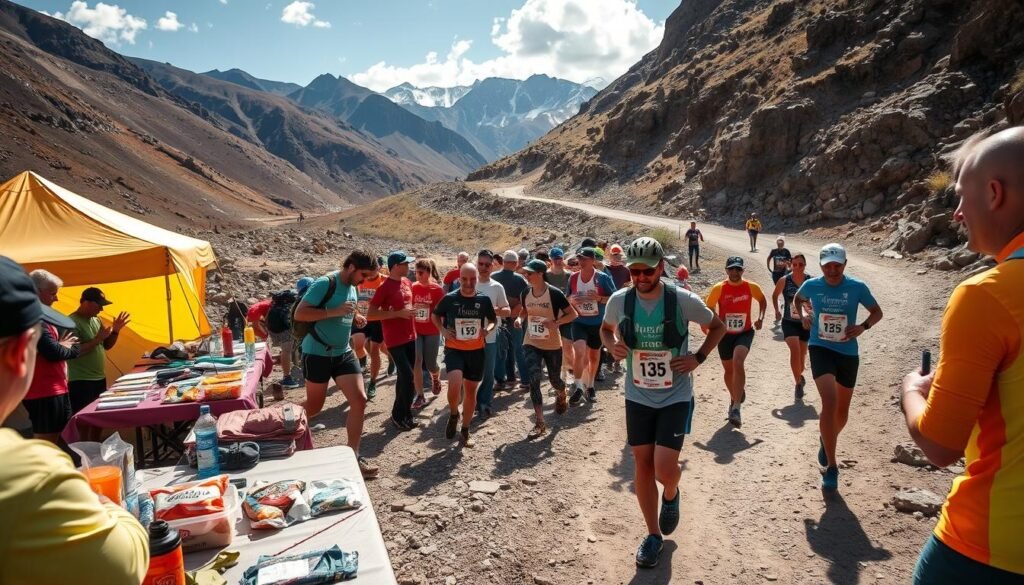
We’re excited to share our expertise on mastering ultramarathon long runs. We’ll give you valuable training tips and running techniques for endurance runners. Ultramarathons are races longer than the standard marathon, ranging from 50 kilometers to over 100 miles. It’s key to have a solid training plan.
We’ll explore the world of ultramarathon running. We’ll talk about the importance of long runs, how to structure them, and preparing for the mental and physical challenges. Our focus will be on mastering ultramarathon long runs and sharing expert training tips and techniques.
Our goal is to equip you with the tools and knowledge to reach your ultramarathon goals. Whether you’re an experienced ultrarunner or just starting, we aim to help you master ultramarathon long runs. We’ll share expert training tips and techniques to help you succeed.
Key Takeaways
- Mastering ultramarathon long runs requires a deep understanding of the sport and a well-structured training plan.
- Ultramarathon training tips include gradually increasing mileage and intensity in a systematic approach.
- Having the right gear, such as trail running shoes and moisture-wicking clothing, can enhance performance and comfort during an ultramarathon.
- Pacing yourself appropriately is critical for successfully completing an ultramarathon.
- Focus on post-race recovery with nutritious meals, hydration, rest, and active recovery activities to aid muscle repair and recovery.
- Gradually easing back into running post-ultra marathon and setting new goals help maintain fitness levels and prepare for future challenges.
Understanding the Fundamentals of Mastering Ultramarathon Long Runs
Exploring ultramarathon distance running reveals its unique aspects. It differs from traditional marathon training. A good ultramarathon nutrition guide is key for fueling and hydration during races.
To build our endurance, we must focus on specific ultramarathon demands. This includes back-to-back long runs and fueling strategies. These steps help us prepare for the race’s challenges and enhance our performance.
What Defines an Ultramarathon
An ultramarathon is any race longer than a traditional marathon (26.2 miles). Distances like 50k, 50 miles, 100k, and 100 miles require unique training. Terrain, elevation, and weather are important factors.
Key Differences from Marathon Training
Ultramarathon training focuses more on endurance and stamina. Runners must maintain a steady pace over long distances. This demands strong cardiovascular fitness and the ability to handle varied terrains and weather.
Building Your Distance Base
To increase our endurance, we should gradually raise our weekly mileage. Incorporating longer runs and fueling strategies is essential. This approach helps us build stamina and reduces injury risks.
- Average finish time for a 100-mile ultramarathon: 24-30 hours
- Cutoff time for many 100-mile ultramarathons: 30 hours
- Preferred walking speed for humans: approximately 19:21/mile
By grasping these basics and applying them to our training, we can tackle ultramarathon challenges. A solid nutrition guide and training plan are vital for success, whether aiming for a 50k or 100-mile race.
Creating Your Progressive Training Schedule
To succeed in ultramarathon running, you need a good training plan. It should include long runs for ultramarathon success, long distance running techniques, and endurance running strategies. Make sure it fits your needs, like your running experience and age.
A good plan mixes different types of runs. You’ll do steady long runs, fast-finish ones, and back-to-back runs. These help your body get better at using fat for energy and improve your endurance.
- Start with shorter runs and gradually increase the distance and intensity
- Incorporate rest and recovery days to allow your body to repair and adapt
- Include strength training to improve running economy and muscular recovery
By following these tips and adding long runs for ultramarathon success, long distance running techniques, and endurance running strategies to your plan, you’ll be on the path to ultramarathon success.
Essential Gear for Ultra Distance Success
Ultramarathon running needs the right gear for success and comfort. This includes ultrarunning shoes, hydration systems, and performance clothing. We’ll guide you on picking the best shoes, hydration systems, and clothing for top performance.
Choosing the right ultrarunning shoes is key. They should support, cushion, and grip well. Hydration systems are also critical for staying hydrated. Look for one that’s comfy, easy to use, and holds enough water.
Performance clothing also plays a big role. It should be breathable, wick moisture, and offer support. Think about the weather and terrain and pick clothes that fit those conditions.
- Salomon ultrarunning shoes
- CamelBak hydration systems
- Patagonia performance clothing
| Gear | Description |
|---|---|
| Ultrarunning shoes | Provide support, cushioning, and traction |
| Hydration systems | Help stay hydrated throughout the race |
| Performance clothing | Provide comfort, support, and breathability |
Building Mental Fortitude for Ultra Distances
Exploring ultrarunning, we see that ultramarathon mental preparation is key to success. The mental side of running is as important as the physical. It’s what makes some runners push through the hardest parts.
To build mental toughness, we must focus on being resilient. We also need to learn to handle fear and doubt.
Using visualization in our training is a great way to start. Seeing ourselves finish strong or overcome hurdles boosts our confidence. Experienced runners also stress the value of positive self-talk and mindfulness. These help manage anxiety and stay focused during long runs.
Some key strategies for mental strength include:
- Creating a pre-run routine with stretching, music, and visualization
- Breaking down long runs into smaller parts and focusing on each
- Practicing mindfulness and deep breathing to deal with pain

By using these strategies, we can build the mental strength needed for ultra distances. Remember, ultramarathon mental preparation is as vital as physical training. By focusing on our mental health, we can reach our full ultrarunning abilities.
Nutrition Strategies for Extended Running
Ultramarathon nutrition is key for top performance. A good nutrition plan helps athletes tackle tough courses. Before the event, aim for 10-12 grams of carbs per kg of body weight for 36-48 hours to fill up muscle glycogen.
During the run, eat 250-300 calories and 45-60 grams of carbs per hour. Some athletes might need up to 90 grams of carbs per hour. Stay hydrated with .5 – 1 liter of water per hour and 500-800 mg of sodium per liter.
After the run, eat a meal with carbs and protein within 2 hours. Drink plenty of water and electrolyte-rich drinks. Avoid too much caffeine and sugary snacks.
- Consume a balanced meal with carbohydrates and protein within 2 hours after the run
- Stay hydrated by drinking plenty of water and electrolyte-rich beverages
- Avoid overconsumption of caffeine and sugary snacks
Creating a solid nutrition plan is vital for ultramarathon success. Focus on fueling right and test your plan in training. Make changes as needed for the best results.
Mastering Terrain-Specific Training
Understanding the ultramarathon terrain is key. This includes trail running and mountain running, which need special skills. Athletes should train on terrain like the race to get better.
Training on hills and doing strength exercises is vital. It helps build endurance and power, important for mountain running. For trail running, agility and balance are key. These can be improved with plyometric exercises and technical runs.
Here are some tips for mastering terrain-specific training:
- Incorporating hill repeats and strength training into your training plan
- Training on terrain similar to the race conditions
- Developing agility and balance through plyometric exercises and technical runs

By following these tips, athletes can get stronger and more endurance. This helps tackle the challenges of ultramarathon terrain, including trail running and mountain running.
| Terrain | Training Tips |
|---|---|
| Mountain | Incorporate hill repeats and strength training |
| Trail | Develop agility and balance through plyometric exercises and technical runs |
Recovery Techniques for Ultra Runners
Ultra runners know how key recovery is in their training. Good recovery methods help us stay injury-free and perform better. Active recovery, like foam rolling and stretching, is vital for easing muscle soreness and boosting flexibility.
Studies show muscle soreness can grow over three days after a marathon. Yet, there’s no big change from before the race to four to seven days later. This shows we need solid recovery methods and injury prevention to heal well and avoid injuries.
Effective recovery techniques for ultra runners include:
- Active recovery methods, such as foam rolling and stretching
- Sleep and rest optimization, aiming for 7-9 hours of sleep per night
- Injury prevention protocols, such as regular massage and self-myofascial release
By using these recovery methods, we can lower injury risk and enhance our performance. As ultra runner Sarah Ostaszewski says, getting enough sleep, eating well, and having a recovery routine are key for top performance. By focusing on recovery, we support our bodies and reach our ultrarunning goals.
Remember, recovery is a big part of ultrarunning. By focusing on recovery, techniques, and injury prevention, we can perform at our best and stay injury-free.
| Recovery Technique | Benefits |
|---|---|
| Active recovery methods | Reduces muscle soreness, improves flexibility |
| Sleep and rest optimization | Supports body’s natural healing process, reduces risk of injury |
| Injury prevention protocols | Minimizes risk of injury, supports long-term health and performance |
Pace Management and Race Strategy
Managing your pace in an ultramarathon is key. It’s important to break the race into smaller segments. This way, you can manage your pace better and avoid getting too tired. A good race strategy also considers the terrain, weather, and what you eat.
Many pros suggest using a run/walk strategy. This means running for a bit, then walking to rest. It helps you manage your pace and save energy for later. Also, don’t forget to stay hydrated and fueled during the race. Bad nutrition can really hurt your performance.
Here are some important things to think about for ultramarathon pacing and race strategy:
- Start slow and get faster as you warm up
- Use pace charts to keep track and adjust as needed
- Be ready to change your plan if the weather or terrain changes

By using these tips and making a solid race strategy, you can do better in ultramarathons. Always listen to your body and adjust as needed. And don’t hesitate to get ultra running advice from seasoned athletes or coaches.
| Ultramarathon Distance | Recommended Pace | Nutrition Strategy |
|---|---|---|
| 50km | Conservative pace with regular walk breaks | Hydrate with electrolyte-rich drinks and fuel with energy gels |
| 100km | Gradually increasing pace with regular walk breaks | Hydrate with electrolyte-rich drinks and fuel with energy gels and solid foods |
Weather Adaptation Training
Ultrarunners face many weather challenges, like extreme heat, cold, and high altitudes. The weather can change quickly, so it’s key to adapt to stay safe and perform well. Heat acclimation is vital, helping our bodies adjust to hot temperatures and humidity.
Heat acclimation shows quick results in the first week, with slower progress after. To fully adapt, athletes need two weeks of focused training. Training in the race environment is best, but indoor heated rooms work too. For example, 12 sauna sessions at 190°F for 30 minutes over three weeks boost endurance.
Cold weather running is also critical. It’s important to wear the right clothes and eat well to keep energy up. Getting used to cold takes effort, but with the right training, we can perform better and avoid injuries. Using ice bandanas, towels, and ice slurries can help cool down and ease heart strain.
Key Weather Adaptation Techniques
- Heat acclimation: train in high temperatures and humidity to adapt our bodies
- Cold weather running: dress appropriately and fuel our bodies to maintain energy levels
- Altitude training: train at high altitudes to adapt our bodies to lower oxygen levels
By using these weather adaptation methods, we can enhance our performance and safety. Whether facing heat, cold, or high altitudes, being ready and adapted is key to success in ultrarunning.
Building Support Systems and Crew Management
Exploring ultrarunning shows us how vital a strong support system and crew management are. It’s not just about having people cheering you on. It’s about having a team that can offer the aid and help you need during the race. When it comes to ultra running advice, building and managing your crew is key.
Experienced ultrarunners agree: a support system can be a game-changer. It means having a team ready to provide food, water, and medical help when you need it. Crew management is also essential. It’s about coordinating your team to ensure you get the support you need at the right time. With a solid crew management plan, you can focus on running while your team takes care of the rest.

Some important things to think about when building your support system and managing your crew include:
- Recruiting and training your crew members
- Communicating with your crew during the race
- Managing your crew’s expectations
- Creating a crew manual to outline roles and responsibilities
By following these tips and focusing on ultramarathon support and crew management, you can set yourself up for success. You’ll be well on your way to achieving your ultra running goals.
Advanced Ultra Running Techniques
Exploring ultramarathon techniques is key to mastering night running, navigating technical trails, and power hiking. These skills are vital for overcoming ultrarunning’s challenges.
Downhills are tough, causing muscle strain in untrained athletes. To tackle this, we use technical trail navigation with headlamps. Night running demands skills for navigating in the dark and through unknown terrain.
Power hiking helps us tackle steep climbs efficiently. It saves energy and keeps our pace up. This method is great for ultramarathons, where terrain and fitness matter.
- Conserving energy and reducing fatigue
- Maintaining a steady pace and delaying muscle fatigue
- Enhancing overall performance and efficiency
By learning these advanced techniques, we can excel in ultrarunning. We’ll be ready for any course, day or night.
Conclusion: Embracing the Ultra Running Journey
The journey of mastering ultramarathon long runs is just as important as reaching the finish line. It’s not just about physical achievements. It’s about finding joy, meaning, and personal growth along the way. Embracing this journey helps us grow, build a community, and take care of ourselves.
As you train and race, take time to reflect on your experiences. Set goals that challenge you but are achievable. Stay motivated and inspired. Celebrate your wins and learn from your losses. Surround yourself with supportive runners who understand the journey.
By following this advice, you’ll find true purpose and joy in your running. This will make your journey more fulfilling and rewarding.